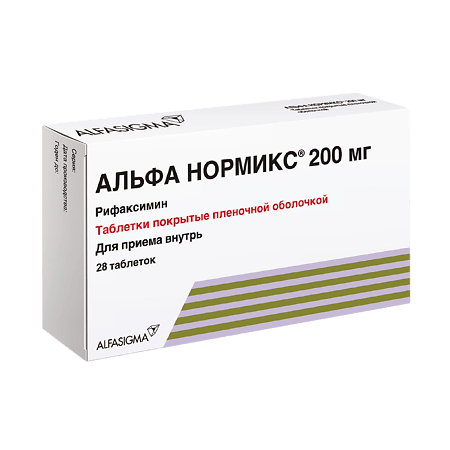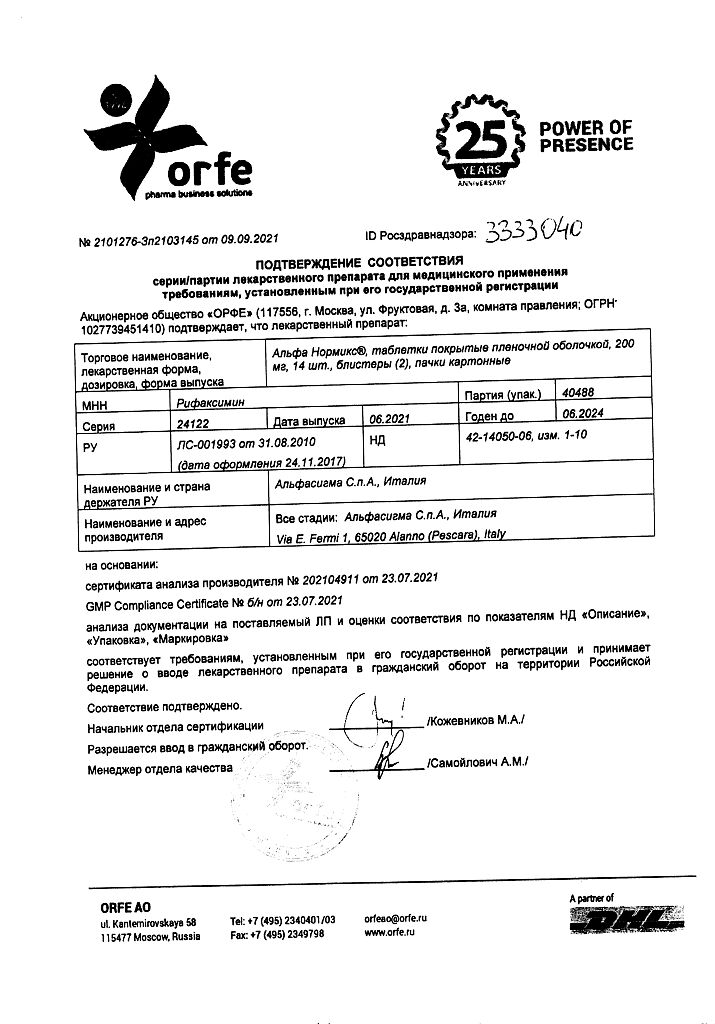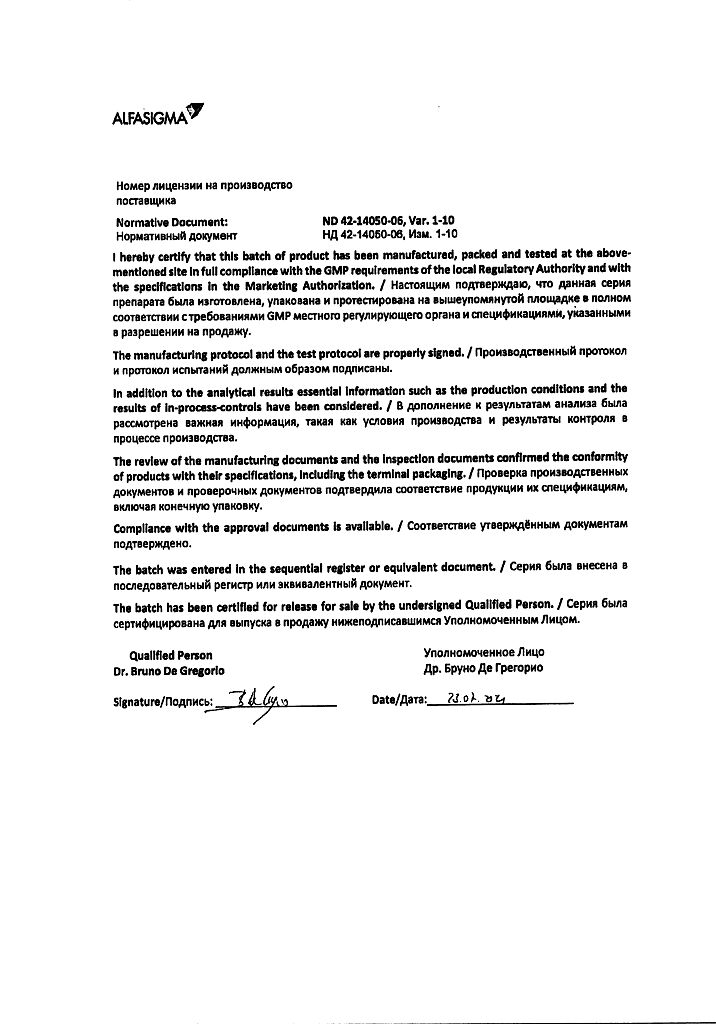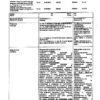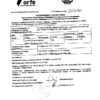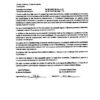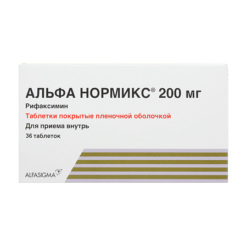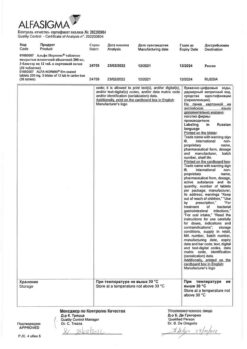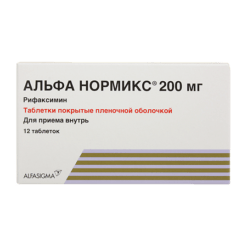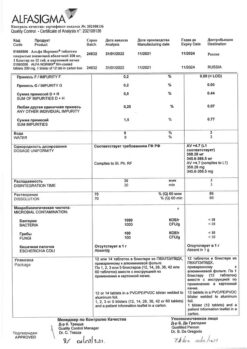No products in the cart.
Alfa Normix, 200 mg 28 pcs.
€47.76 €39.80
Description
Pharmacological action Pharmacological action – antibacterial.
Pharmacodynamics
Rifaximin is a broad spectrum antibiotic of the rifamycin group. Like other representatives of this group it irreversibly binds beta-subunits of bacteria enzyme DNA-dependent RNA polymerase and, therefore, inhibits synthesis of RNA and proteins in bacteria.
As a result of irreversible binding to the enzyme, rifaximin exhibits bactericidal properties against sensitive bacteria. The drug has a wide spectrum of antimicrobial activity including most gram-negative and gram-positive, aerobic and anaerobic bacteria.
The wide antibacterial spectrum of rifaximin helps to reduce pathogenic intestinal bacterial load that causes some pathological conditions.
The drug reduces:
– production by bacteria of ammonia and other toxic compounds, which in the case of severe liver disease, accompanied by impaired detoxification process, play a role in the pathogenesis and clinical manifestations of hepatic encephalopathy;
– increased bacterial proliferation in gut microbial overgrowth syndrome;
– the presence of bacteria in the colonic diverticulum, which may cause inflammation in and around the diverticular sac and may play a key role in the development of symptoms and complications of diverticular disease;
– an antigenic stimulus that, in the presence of genetically determined defects in mucosal immunoregulation and/or protective function, may initiate or permanently maintain chronic intestinal inflammation;
The risk of developing infectious complications in colorectal surgery.
The mechanism of resistance. The development of resistance to rifaximin is due to reversible damage to the rpoB gene that encodes bacterial RNA polymerase. The incidence of resistant subpopulations among bacteria isolated from patients with traveler’s diarrhea was low.
According to clinical studies, a three-day course of rifaximin therapy in patients with traveler’s diarrhea was not accompanied by the occurrence of resistant Gram-positive (enterococci) and Gram-negative (E. coli) bacteria. When rifaximin was repeatedly administered at high doses in healthy volunteers and patients with inflammatory bowel disease, rifaximin-resistant strains appeared, but they did not colonize the GI tract or displace rifaximin-sensitive strains.
The resistant strains quickly disappeared when therapy was discontinued. Experimental and clinical data suggest that the use of rifaximin in patients with traveler’s diarrhea and latent Mycobacterium tuberculosis and Neisseria meningitidis infection will not be accompanied by selection of rifampicin-resistant strains.
Sensitivity. In vitro sensitivity testing cannot be used to determine the sensitivity or resistance of bacteria to rifaximin. There is currently insufficient clinical data to establish limits for evaluating sensitivity tests. Rifaximin was evaluated in vitro against traveler’s diarrhea pathogens from four regions of the world: enterotoxigenic and enteroaggregative strains of E. coli, Salmonella spp., Shigella spp., noncholera vibrios, Plesiomonas spp., Aeromonas spp. and Campylobacter spp. The MPC90 for the isolated strains was 32 μg/mL, and this level was easily attainable in the intestinal lumen as a result of the high concentration of rifaximin in the feces. Because rifaximin in polymorphic alpha has low gastrointestinal absorption and acts locally in the gut lumen, it may not be clinically effective against invasive bacteria even if these bacteria are sensitive to it in vitro.
Pharmacokinetics
Intake. Rifaximin in polymorphic form alpha is practically not absorbed when administered orally (less than 1%). When repeated use in healthy volunteers and patients with damaged intestinal mucosa and inflammatory bowel disease, plasma concentrations are very low (less than 10 ng/ml). When using the drug 30 min after a fatty meal, an increase in systemic absorption of rifaximin of no clinical significance was observed.
Distribution. Rifaximin is moderately bound to plasma proteins. Protein binding in healthy volunteers is 67.5%, in patients with hepatic impairment – 62%.
Elimation. It is excreted unchanged in intestinal form (96.9% of the administered dose), because it is not degraded and metabolized during passage through the gastrointestinal tract.
Rifaximin detected with labeled isotopes in urine is not more than 0.025% of the oral dose. Less than 0.01% of the dose is excreted by the kidneys as 25-desacetylrifaximin, the only rifaximin metabolite identified in humans. Renal excretion of 14C rifaximin does not exceed 0.4%. Systemic exposure is nonlinear, dose-dependent, which is comparable to the absorption of rifaximin, possibly limited by the rate of dissolution.
Particular patient groups
With renal impairment. There are no clinical data on the use of rifaximin in renal failure.
With hepatic impairment. Systemic exposure in patients with hepatic impairment is greater than in healthy volunteers. Increased systemic exposure in these patients should be considered in light of the local action of rifaximin in the gut and its low systemic bioavailability, as well as available data on the safety of rifaximin in patients with cirrhosis.
Children. The pharmacokinetics of rifaximin in children have not been studied/
.
Indications
Indications
– acute gastrointestinal infections;
– traveler’s diarrhea;
– gut microbial overgrowth syndrome;
– hepatic encephalopathy;
– symptomatic uncomplicated diverticular disease of the colon;
– chronic inflammatory bowel disease.
Active ingredient
Active ingredient
Composition
Composition
Each film-coated tablet contains:
The active ingredient:
Rifaximin with polymorphic structure alpha 200 mg.
Excipients:
sodium carboxymethyl starch 15 mg,
glyceryl palmitostearate 18 mg,
Colloidal silica 1 mg,
talc 1 mg,
microcrystalline cellulose 115 mg.
Film jacket:
hypromellose 5.15 mg,
titanium dioxide (E171) 1.5 mg,
Edetate 0,02 mg,
Propylene glycol 0,5 mg,
Iron oxide (E172) 0,15 mg/.
How to take, the dosage
How to take, the dosage
Take orally with a glass of water, regardless of meals.
The treatment of diarrhea
Adults and children over 12 years: 1 tablet of 200 mg or 10 ml of suspension (equivalent to 200 mg of rifaximin) every 6 hours. Treatment of traveler’s diarrhea should not exceed 3 days.
Hepatic encephalopathy:
Adults and children over 12 years of age: 2 tablets of 200 mg or 20 ml
suspension (equivalent to 400 mg of rifaximin) every 8 hours. Prevention of postoperative complications during colorectal surgery:
Adults and children over 12 years of age: 2 tablets of 200 mg or 20 ml of suspension (equivalent to 400 mg of rifaximin) every 12 hours.
The prophylaxis is given 3 days before surgery.
Bacterial overgrowth syndrome:
Adults and children over 12 years of age: 2 tablets of 200 mg every 8-12 hours.
Symptomatic uncomplicated diverticulosis:
Adults and children over 12 years of age: 1 to 2 200 mg tablets or 10 to 20 ml of suspension (equivalent to 200 to 400 mg of rifaximin) every 8 to 12 hours.
Chronic inflammatory bowel disease:
Adults and children over 12 years of age: 1- 2 tablets of 200 mg or 10 to 20 ml of suspension (equivalent to 200 to 400 mg of rifaximin) every 8 to 12 hours.
The duration of treatment with Alfa Normix should not exceed 7 days. A repeat course of treatment should not be carried out earlier than after 20 to 40 days. The total duration of treatment is determined by the clinical condition of patients. The doses and frequency of administration may be changed according to the doctor’s recommendation.
Dose adjustment is not necessary in elderly patients and in patients with hepatic and renal insufficiency.
Preparation of suspension
Pellets for oral suspension are in a hermetically sealed bottle. To make the suspension, open the bottle, add water to the mark and shake the bottle vigorously. Repeat the addition of water until the level of the suspension reaches the 60 ml mark indicated.
The concentration of rifaximin in the suspension prepared is 100 mg in 5 ml. Shake the suspension well before use. Measure the ready-to-use suspension with the measuring cup included in the package.
Interaction
Interaction
In vitro studies show that Rifaximin does not inhibit cytochrome P-450 isoenzymes (CYP1A2, 2A6, 2B6, 2C8, 2C9, 2C19, 2D6, 2E1 and 3A4) and does not induce CYP1A2 and CYP2B6, but is a weak CYP3A4 inducer. Clinical studies of drug interactions indicate that in healthy volunteers rifaximin has no significant effect on pharmacokinetics of drugs metabolized with participation of CYP3A4. In patients with impaired liver function, it cannot be excluded that rifaximin may decrease the exposure of substrate drugs of CYP3A4 (e.g., warfarin, antiarrhythmic, anticonvulsants, etc.) when used concomitantly with them, because in hepatic impairment it has higher systemic exposure compared to healthy volunteers.
In patients continuing warfarin and rifaximin, decreased and increased international normalized ratio have been reported (in some cases with bleeding episodes). If co-administration is necessary, the international normalized ratio should be monitored closely at the beginning and end of treatment. Dose adjustments of oral anticoagulants may be necessary to maintain the desired level of anticoagulation.
In vitro studies suggest that rifaximin is a moderate substrate of P-glycoprotein and is metabolized by the CYP3A4 isoenzyme.
It is not known whether drugs that inhibit CYP3A4 increase systemic exposure to rifaximin when used concomitantly with it.
In healthy volunteers, co-administration of a single dose of cyclosporine (600 mg), a potent P-glycoprotein inhibitor, and a single dose of rifaximin (550 mg) resulted in 83-fold and 124-fold increases in the mean Cmax and AUCâ of rifaximin. The clinical significance of this increase for systemic exposure is not known.
Potential interactions of rifaximin with other drugs that are eliminated from the cell by P-glycoprotein or other transport proteins (MRP2, MRP4, BCRP, BSEP) are unlikely.
Special Instructions
Special Instructions
Clinical data indicate that the drug Alpha Normix® is ineffective in the treatment of intestinal infections caused by Campylobacter jejuni, Salmonella spp., Shigella spp. which cause frequent diarrhea, fever, discharge of blood with stool. The drug Alpha Normix® is not recommended if patients have fever and liquid stools with blood. Alpha Normix® should be discontinued if diarrhea symptoms worsen or persist for more than 48 hours. Other antibiotic therapy should be prescribed. Treatment of traveler’s diarrhea should not exceed 3 days.
It is known that Clostridium difficile-associated diarrhea can develop with almost all antibacterial agents, including the drug Alpha Normix®. A potential association of Alpha Normix® with the development of Clostridium difficile-associated diarrhea and pseudomembranous colitis cannot be excluded. There is no experience with rifaximin combined with other rifamycins.
Caution should be exercised with concomitant administration of rifaximin and a P-glycoprotein inhibitor such as cyclosporine.
Patients should be cautioned that although rifaximin is slightly absorbed (less than 1%), it can cause a reddish coloring of the urine: this is due to the active ingredient rifaximin which, like most antibiotics in this series (rifamycins), is reddish orange.
In case of superinfection with microorganisms insensitive to rifaximin, the use of Alpha Normix® should be stopped and an appropriate therapy should be prescribed.
Due to the effect of the drug Alpha Normix® on the intestinal flora, the effectiveness of oral contraceptives containing estrogens may decrease after its administration. It is recommended to use additional contraceptive measures while taking Alpha Normix®, especially if the estrogen content of oral contraceptives is less than 50 mcg.
Alpha Normix® may not be taken earlier than 2 hours after taking activated charcoal.
The granules for preparation of suspension for oral administration contain sucrose; therefore, the drug Alpha Normix® in this dosage form must not be used if there is hereditary fructose intolerance, glucose-galactose malabsorption disorder or insufficiency of sucrose-isomaltase.
Influence on driving and operating ability
While dizziness and somnolence are observed when using Alfa Normix ®, it does not significantly influence the ability to drive vehicles and engage in activities requiring increased attention and quick psychomotor reactions. In case of dizziness and somnolence when using the drug, the following activities should be avoided.
Contraindications
Contraindications
– Hypersensitivity to rifaximin or other rifamycins or any of the ingredients in the drug;
– Diarrhea with fever and liquid stools with blood;
– Intestinal obstruction (including partial obstruction).including partial);
– severe ulcerative bowel disease;
– children under 12 years of age (efficacy and safety not established).
With caution: renal failure, concomitant use with oral contraceptives, concomitant use with P-glycoprotein inhibitor such as cyclosporine.
Side effects
Side effects
Side effects are classified by frequency as follows: very common (â¥1/10), common (â¥1/100 to Ë1/10), infrequent (â¥1/1000 to Ë1/100), rare (â¥1/10000 to Ë1/1000), very rare (Ë1/10000), unknown (frequency cannot be determined based on available data).
Cardiovascular system disorders:
Infrequent: palpitations, “rushes” of blood to the skin of the face, increased blood pressure.
Blood disorders:
Infrequent: lymphocytosis, monocytosis, neutropenia.
Unknown: thrombocytopenia.
Immune system disorders:
Unknown: anaphylactic reactions, hypersensitivity, anaphylactic shock, laryngeal edema.
Metabolic disorders:
Infrequent: decreased appetite, dehydration.
Mental disorders:
Infrequent: abnormal dreams, depressed mood, insomnia, nervousness.
Anxiety of the central nervous system:
Often: dizziness, headache.
Infrequent: hypoesthesia, migraine, paresthesia, drowsiness, sinus headache.
Unknown: preconsciousness, agitation.
Visual side:
Infrequent: diplopia.
Internal ear:
Infrequent: ear pain, systemic dizziness.
Respiratory system disorders:
Infrequent: shortness of breath, dry throat, nasal congestion, oropharyngeal pain, cough, rhinorrhea.
Gastrointestinal and liver disorders:
Often: bloating, abdominal pain, constipation, diarrhea, flatulence, nausea, tenesmus, vomiting, urge to defecate.
Infrequent: pain in the upper abdomen, ascites, dyspepsia, abnormal gastrointestinal motility, mucus and blood discharge in stool, dry lips, “hard” stool, increased aspartataminotransferase activity, aguesia.
Unknown: impairment of hepatic functional tests, heartburn.
Urinary system disorders:
Infrequent: glucosuria, polyuria, pollakiuria, hematuria, proteinuria.
Skin and subcutaneous fatty tissue:
Infrequent: rash, sunburn.
Unknown: angioedema, allergic dermatitis, exfoliative dermatitis, eczema, erythema, pruritus, purpura, urticaria, erythematous rash, erythema of the palms, itching of the genitals.
Musculoskeletal system disorders:
Infrequent: back pain, muscle spasm, muscle weakness, myalgia, neck pain.
Infections:
Infrequent: candidiasis, herpes simplex, nasopharyngitis, pharyngitis, infections
upper respiratory tract.
Unknown: clostridial infection.
Reproductive system disorders:
Infrequent: polymenorrhea.
General symptoms:
Often: fever.
Infrequent: asthenia, pain and discomfort of uncertain location, chills, cold sweats, flu-like symptoms, peripheral edema, hyperhidrosis, facial edema, fatigue.
Laboratory tests: change in international normalized ratio.
Overdose
Overdose
In patients with traveler’s diarrhea, doses of rifaximin up to 1800 mg/day were well tolerated, according to clinical studies.
Even in patients with normal gut bacterial flora, rifaximin at doses up to 2400 mg/day for 7 days did not cause adverse symptoms.
In accidental overdose, symptomatic and supportive therapy is indicated.
Pregnancy use
Pregnancy use
The data on the use of Alpha Normix® in pregnancy are very limited.
Animal studies have shown a transient effect of rifaximin on fetal ossification and skeletal structure. The clinical significance of these results is unknown. The use of Alfa Normix® in pregnancy is not recommended.
It is not known whether rifaximin penetrates into breast milk. A risk to the breastfed baby cannot be excluded. To decide whether to continue rifaximin while breastfeeding, the balance of risk to the baby versus benefit to the mother must be evaluated.
Additional information
| Shelf life | 3 years. Do not use after the expiration date stated on the package. |
|---|---|
| Conditions of storage | At a temperature not exceeding 30 °C. Keep out of reach of children. |
| Manufacturer | Alphasigma S.p.A., Italy |
| Medication form | pills |
| Brand | Alphasigma S.p.A. |
Other forms…
Related products
Buy Alfa Normix, 200 mg 28 pcs. with delivery to USA, UK, Europe and over 120 other countries.

